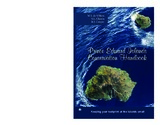- ALSA Home
- →
- Multimedia
- →
- Resources
- →
- View Item
JavaScript is disabled for your browser. Some features of this site may not work without it.
| dc.contributor | South African National Antarctic Programme | en_ZA |
| dc.contributor.author | De Villiers, Marienne | |
| dc.contributor.author | Cooper, John | |
| dc.contributor.author | Chown, Steven | |
| dc.date.accessioned | 2019-07-25T13:36:37Z | |
| dc.date.available | 2019-07-25T13:36:37Z | |
| dc.date.created | 2011 | |
| dc.identifier.uri | http://hdl.handle.net/123456789/15327 | |
| dc.description.abstract | As an expeditioner to the sub-Antarctic Prince Edward Islands (PEI's, comprising Marion Island and Prince Edward Island), you are one of a few privileged people who will have the chance to visit South Africa’s only volcanoes, see nesting albatrosses, inspect 23 types of plants that you won’t find in any other part of the country, build a snow person, find a rare flightless moth, gaze in awe at one of the largest King Penguin colonies in the world, walk for kilometres without seeing a single piece of litter, spot Killer Whales, and take photo graphs of relics left by sealers at the islands a hundred years ago. But the islands’ natural systems are fragile and easily disturbed. Every action we take results in a reaction. We can do untold damage to this unique place by polluting its environment (page 29), introducing new species of plants or insects to the islands (page 37), disturbing its wildlife (page 48), or damaging its historical legacy (page 66). For this reason, the number of visitors to the PEIs is strictly controlled. Only 80 people may overnight at Marion at any one time, and there are even greater restrictions on visits to Prince Edward (see page 6). The reason you’re going to the PEIs is that you are part of a research, conservation or weather-monitoring programme there, or are going to provide essential logistical support for such programmes, or are going to provide media coverage for events at the islands. You are definitely not a tourist – no onshore tourism is allowed at the Prince Edwards in terms of its status as a Special Nature Reserve. The Prince Edward Islands Management Plan1 provides detailed guidance on environmental practice at the PEIs and should be read by every visitor to the islands. This booklet summarises the information in the management plan that is of most relevance to you. It thus arms you with the information that will help you to minimise your impacts on the islands, and help you to protect their amazing animals, plants and natural systems. In other words, this booklet will help you to keep your footprint at the islands as small as possible. | en_ZA |
| dc.description.sponsorship | Sponsored by the National Research Foundation (South Africa) | en_ZA |
| dc.description.statementofresponsibility | Antarctic Legacy of South Africa | en_ZA |
| dc.language | English | en_ZA |
| dc.language.iso | en_ZA | en_ZA |
| dc.publisher | SUNMEDIA | en_ZA |
| dc.rights | Copyright | en_ZA |
| dc.subject | Research | en_ZA |
| dc.title | Prince Edward Islands Conservation Handbook | en_ZA |
| dc.type | Book | en_ZA |
| dc.rights.holder | South Africa National Antarctic Programme | en_ZA |
| iso19115.mdconstraints.uselimitation | This item and the content of this website are subject to copyright protection. Reproduction of the content, or any part of it, other than for research, academic or non-commercial use is prohibited without prior consent from the copyright holder. The text in this booklet may be quoted for educational/non-commercial purposes provided the source is acknowledged. Recommended citation De Villiers, M.S., Chown, S.L. & Cooper, J. 2011. Prince Edward Islands Conservation Handbook: Keeping your footprint at the islands small. Stellenbosch: SUN PRESS. | en_ZA |
| iso19115.mdidentification.deliverypoint | Antarctic Legacy of South Africa, Faculty of Science, Private Bag X1, Matieland. Stellenbosch. South Africa. | en_ZA |
| iso19115.mdidentification.electronicmailaddress | antarcticlegacy@sun.ac.za | en_ZA |
Files in this item
This item appears in the following Collection(s)
-
Resources [9]
Documents compiled within or for the SANAP community

